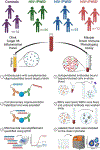Immune profiling in Puerto Rican injection drug users with and without HIV-1 infection
- PMID: 37042743
- PMCID: PMC10776106
- DOI: 10.1093/jleuko/qiad045
Immune profiling in Puerto Rican injection drug users with and without HIV-1 infection
Abstract
Antiretroviral therapy has been effective in suppressing HIV viral load and enabling people living with HIV to experience longer, more conventional lives. However, as people living with HIV are living longer, they are developing aging-related diseases prematurely and are more susceptible to comorbidities that have been linked to chronic inflammation. Coincident with HIV infection and aging, drug abuse has also been independently associated with gut dysbiosis, microbial translocation, and inflammation. Here, we hypothesized that injection drug use would exacerbate HIV-induced immune activation and inflammation, thereby intensifying immune dysfunction. We recruited 50 individuals not using injection drugs (36/50 HIV+) and 47 people who inject drugs (PWID, 12/47 HIV+). All but 3 of the HIV+ subjects were on antiretroviral therapy. Plasma immune profiles were characterized by immunoproteomics, and cellular immunophenotypes were assessed using mass cytometry. The immune profiles of HIV+/PWID-, HIV-/PWID+, and HIV+/PWID+ were each significantly different from controls; however, few differences between these groups were detected, and only 3 inflammatory mediators and 2 immune cell populations demonstrated a combinatorial effect of injection drug use and HIV infection. In conclusion, a comprehensive analysis of inflammatory mediators and cell immunophenotypes revealed remarkably similar patterns of immune dysfunction in HIV-infected individuals and in people who inject drugs with and without HIV-1 infection.
Keywords: Olink; PLWH; PWID; inflammation; mass cytometry; soluble mediators; speedball.
© The Author(s) 2023. Published by Oxford University Press on behalf of Society for Leukocyte Biology. All rights reserved. For permissions, please e-mail: journals.permissions@oup.com.
Conflict of interest statement
Conflict of interest statement. None declared.
Figures





References
-
- Colon HM, Finlinson HA, Robles RR, Deren S, Andía J, Kang SY, Oliver-Vélez D. Joint drug purchases and drug preparation risk behaviors among Puerto Rican injection drug users. AIDS Behav. 2001:5(1):85–96. 10.1023/A:1009515723223 - DOI
-
- Colón HM, Robles RR, Deren S, Sahai H, Finlinson HA, Andía J, Cruz MA, Kang SY, Oliver-Vélez D. Between-city variation in frequency of injection among Puerto Rican injection drug users: east Harlem, New York, and Bayamon, Puerto Rico. J Acquir Immune Defic Syndr. 2001:27(4):405–413. 10.1097/00126334-200108010-00012 - DOI - PubMed
-
- Van Handel MM, Rose CE, Hallisey EJ, Kolling JL, Zibbell JE, Lewis B, Bohm MK, Jones CM, Flanagan BE, Siddiqi AE, et al. County-level vulnerability assessment for rapid dissemination of HIV or HCV infections among persons who inject drugs, United States. J Acquir Immune Defic Syndr. 2016:73(3):323–331. 10.1097/QAI.0000000000001098 - DOI - PMC - PubMed
Publication types
MeSH terms
Grants and funding
LinkOut - more resources
Full Text Sources
Medical

